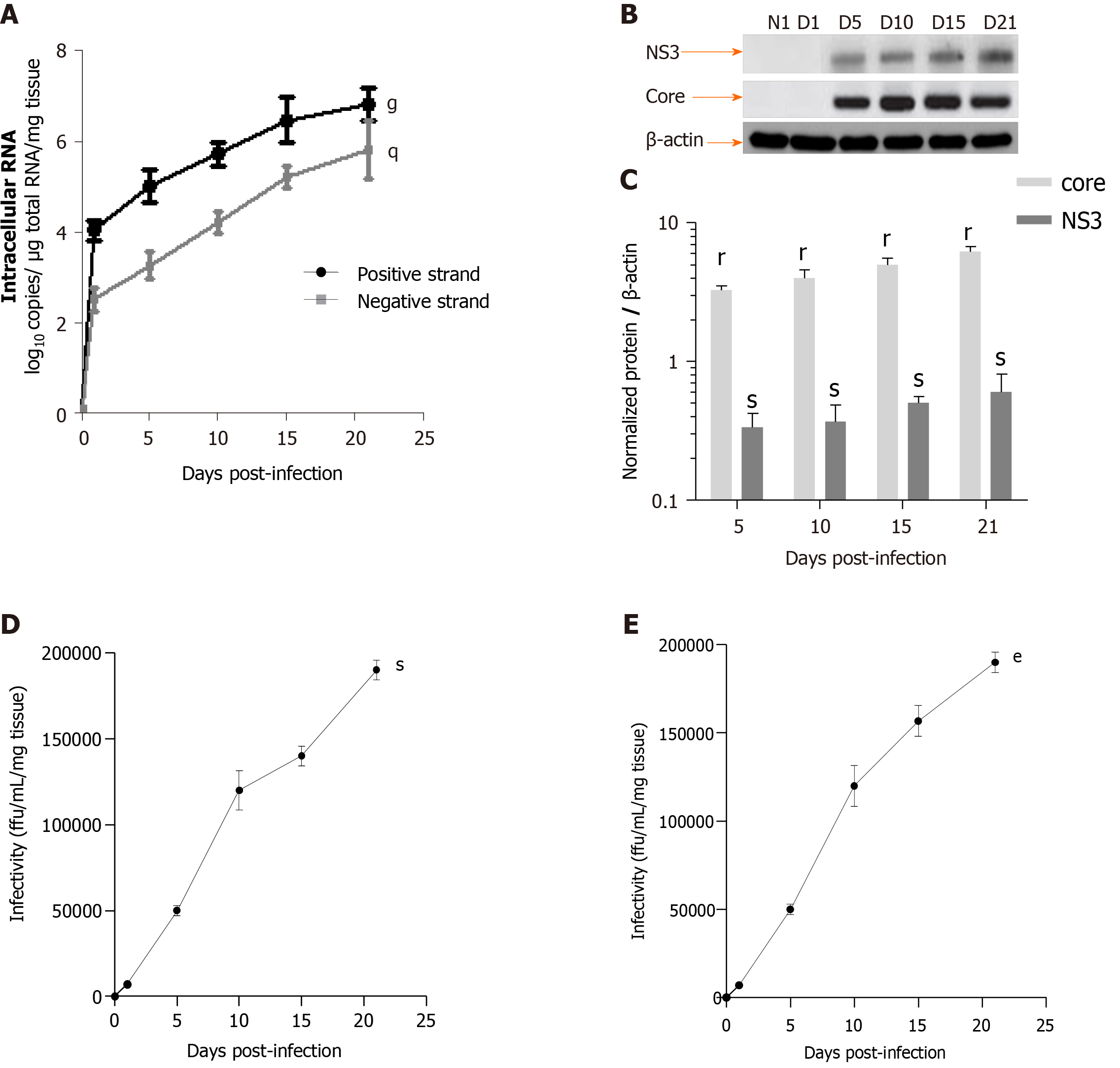Copyright
©The Author(s) 2021.
World J Hepatol. Feb 27, 2021; 13(2): 187-217
Published online Feb 27, 2021. doi: 10.4254/wjh.v13.i2.187
Published online Feb 27, 2021. doi: 10.4254/wjh.v13.i2.187
Figure 5 Efficient replication of hepatitis C virus RNA, and hepatitis C virus core and NS3 proteins expression in human F0-F1 liver slice culture as shown by real-time reverse transcription-quantitative polymerase chain reaction and western blotting analysis.
A: Quantification of intracellular levels of positive- and negative-strand hepatitis C virus (HCV) RNA (log10 copies/µg total RNA/mg tissue) in primary human F0-F1 HCVcc Con1/C3 -infected liver slice (LS) by specific- strand real-time reverse transcription-quantitative polymerase chain reaction on day 5, day 10, day 15 and day 21 post-infection. Values are expressed as mean ± SEMs. All results were compared using the two-paired Student t-test, time factor: Positive strand: gP < 0.01; negative strand: qP < 0.04, (n = 3). Detection of the negative strand of HCV RNA evidences active replication as well as an increase over time of both positive and negative strands of HCV RNA; B: Western blotting analysis of human F0-F1 HCVcc Con-1/C3 -infected LS lysates with mAbs against HCV NS3 or core proteins on day 5, day 10, day 15, and day 21, post-infection (MOI = 0.1) was performed and analyzed (n = 3). Lysates of naïve human F0-F1 LS lysates were run in parallel to serve as a negative controls (NI). β-actin was used as a loading control; C: Normalization of Core and NS3 protein expression compared to b-actin expression (Normalized protein / β-actin) during the 21 days follow-up kinetics using the image quantification standard software, ImageJ2[21]. The position of molecular-weight markers is indicated in kDa. Values are expressed as means ± SEMs (n = 3): Core rP < 0.002; NS3 sP < 0.02 (two-paired Student t-test); D: Production of HCV infectious particles (genotype 1b) in primary adult human F0-F1 LS: Infectivity titers [i.e., infectivity (ffu/mL/mg tissue)] of culture supernatants from human F0-F1 LS infected by the Con1/C3 virus during the 21 days follow up kinetics. The curve represents the average of three independent infections from 3 different donors. Each kinetic study was performed in triplicate. Values are expressed as means ± SEMs. Results were compared using the two-paired Student t-test: sP < 0.02; and E: Infectivity titers [i.e., infectivity (ffu/mL/mg tissue)] of culture supernatants of naive F0-F1 LS infected with supernatants from human F0- F1 HCV-infected LS culture (HCVpc) during the 21 days follow up kinetics. The infection of naive F0-F1 LS with supernatants from human F0-F1 HCV-infected LS culture (HCVpc) clearly indicates the infectivity of extracellular viral particles, which are produced by HVCcc Con1/ C3 (genotype 1b) infection. Values are expressed as means ± SEMs (n = 3). Levels of significance: eP < 0.001 (two-paired Student t-test).
- Citation: Kartasheva-Ebertz D, Gaston J, Lair-Mehiri L, Massault PP, Scatton O, Vaillant JC, Morozov VA, Pol S, Lagaye S. Adult human liver slice cultures: Modelling of liver fibrosis and evaluation of new anti-fibrotic drugs. World J Hepatol 2021; 13(2): 187-217
- URL: https://www.wjgnet.com/1948-5182/full/v13/i2/187.htm
- DOI: https://dx.doi.org/10.4254/wjh.v13.i2.187









